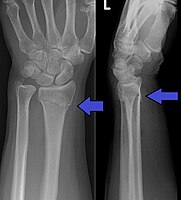
Photo from wikipedia
Background Distal radius fractures are very common in paediatric patients. Severely displaced fractures may require surgical intervention. The gold standard surgical method is percutaneous K-wire osteosynthesis followed by immobilisation. Metal… Click to show full abstract
Background Distal radius fractures are very common in paediatric patients. Severely displaced fractures may require surgical intervention. The gold standard surgical method is percutaneous K-wire osteosynthesis followed by immobilisation. Metal implants can be removed with a second intervention; however, these extra procedures can cause further complications. Several studies confirm the benefits of bioabsorbable implants for paediatric patients. The aim of this retrospective study was to compare the complication rates of displaced distal metaphyseal radius (AO 23r-M/3.1) and forearm (AO 23-M/3.1) fractures in children operated on with K-wires versus a novel technique with bioresorbable implants. Methods We retrospectively reviewed 94 patients in three paediatric trauma centres who underwent operations due to severely displaced distal forearm or metaphyseal radial fractures between January 2019 and January 2020. The mean age was 8.23 (ranging from 5–12). 30 patients (bioresorbable group, BR-group) were treated with biodegradable PLGA implants (Bioretec®, ActivaPin®), 40 patients with one or two stainless steel Kirschner-wires (K-wires, Sanatmetal®) which were buried under the skin (KW I-group) and 24 children with K-wires left outside the skin. (KWII. Group). We examined the number of minor and major complications as well as the need for repeated interventions. Follow-up was at least one and half year. Results There was no significant difference between the complication rates at the two KW groups ( p = 0.241; Cramer’s V = 0.211), while the complication rate of the BR group was significantly lower. ( p = 0.049; Cramer’s V = 0.293 and p = 0.002; Cramer’s V = 0.418 respectively). No later than half a year after the injury, no difference was observed between the functional outcomes of the patients in each group. One and a half years after the injury, no signs of growth disturbance were found in any of the children. No second surgical intervention was required in the BR group. Conclusions Surgeries with bioresorbable intramedullary implants may have fewer complications than K- wire osteosynthesis in the treatment of severely displaced distal forearm fractures. The benefits are most pronounced in the first six weeks after surgery, reducing the number of outpatient visits and increasing the child's sense of comfort. As no second intervention is required, this can lead to significant cost savings. After half a year, there is no difference in the outcomes between the different surgical treatment strategies.
Journal Title: BMC Musculoskeletal Disorders
Year Published: 2022
Link to full text (if available)
Share on Social Media: Sign Up to like & get
recommendations!